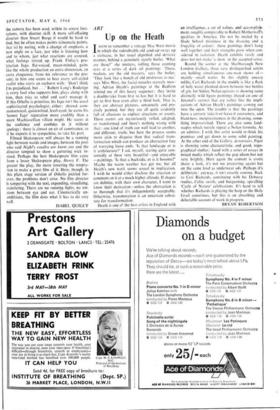Up on the Heath
T SEEM to remember a vintage Mae West movie in which the redoubtable old send-up sways up a staircase, in her usual dignified and derisive manner, behind a genuinely stately butler. 'What are these?' she mutters, rolling those cunning eyes at a series of dark oil paintings 'These, madam, are the old masters,' says the butler. 'They look like a bunch of old mistresses to me,' says Miss West, the facial muscles scarcely mov- ing. Adrian Heath's paintings at the Redfern remind me of this hoary sequence : they invite a double-take from first to last but it is hard to get to first base even after a third look. That is, they are abstract pictures, sensuously and pre- cisely painted, but they are all quite evidently full of allusions to explicit situations or events. These events are mysteriously veiled, adapted, or transformed and there's nothing wrong with that: one kind of truth can well lead to another, and different, truth; but here the process seems more akin to disguise than that radical trans- formation which can produce an abstraction free of worrying loose ends. 'Is that landscape or is it architecture?' I ask myself, staring quite con- tentedly at these very beautiful—and enjoyable —paintings. 'Is that a backside, or is it bosoms?' Maybe the warm weather has got me, but all Heath's new work seems sexual in implication. I wish he would either disclose the situation or comment on it at a much higher altitude. If shapes are definite, with their own character, 1 want to know their derivation—unless the abstraction is so thorough that it's independently acceptable. Otherwise, transmutation is an uncertain substi- tute for transformation.
Heath is one of the best artists in England with an intelligence, a set of values, and accomplish• ment, roughly comparable to Robert Motherwelrs qualities in America. Do not be misled by a Slade School mistiness in the drawing and a frugality of colour: these paintings don't hang well together and their strengths grow when con- sidered in isolation. Heath exhibits rarely and does not not make 'a show' in the accepted sense.
Round the corner at the Marlborough New London Gallery, three very distinguished artists are holding simultaneous one-man shows of- mainly—small works. In this slightly uneasy melee, Ceri Richards in the middle is like a flask of holy water plonked down between two bottles of gin, for Sidney Nolan upstairs is showing some distinctly wild figure paintings (based on one of Juvenal's satires) that are rather like the impli- cations of Adrian Heath's paintings coming out into the open. The trouble is that the paintings have a cursory take-it-or-leave-it coarseness, and blankness; inexpressiveness in the drawing, some- thing impoverished. There are also some land- scapes which merely repeat a Nolan formula. As an admirer, I wish this artist would re-think his premises and get down to some solid painting. At the other end of the Gallery, downstairs. Piper is showing some characteristic, and good, topo- graphical studies: laced with a series of essays in mixed media which reflect the pop idiom but not very brightly. Here again the content is erotic (have a look, it's not me projecting again) but on the same level as underwear ads. Perhaps it's deliberate: anyway, it isn't exactly rousing. Back to Ceri Richards, continuing with his Debussy studies, Celtic swirls, and burgeoning, spiralling 'Cycle of Nature' celebrations. It's hard to tell whether Richards is playing the harp or the Holy Grail sometimes, but this is an absorbing and delectable account of work in progress.
BRYAN ROBERTSON


































 Previous page
Previous page